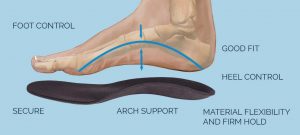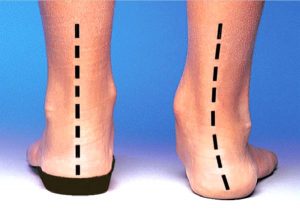Orthotic insoles, as foot orthopedic aids, are the product of the combination of biomechanics, orthopedics, human exercise science, biomedical engineering, and other disciplines. It is a relatively good conservative intervention method for the problem of the line of force of the feet and lower limbs.
However, in China, people are not paying enough attention to foot problems, and orthotic insoles have not yet been popularized, resulting in generally low awareness of orthotic insoles by the public, and subjective assumptions have inevitably caused many misunderstandings.
Today, we will share with you 6 common misunderstandings of orthotic insoles.
1. The softer the insole, the better? NO!
Many people think that the softer the insole, the better, the softer the more comfortable.
In fact, soft insoles only provide a certain amount of cushioning. Sometimes they are not only ineffective for our feet and body health but also indulge or aggravate the problems of the body itself.
High-quality insoles should have both comfort and functionality, “soft and hard”.

The medial arch of the foot should be supportive and the heel around the heel should be able to stabilize and protect the ankle joint. At the same time, the bottom of the heel should be soft to cushion the impact, and the forefoot should be made of soft materials that will not affect or facilitate kicking off.
For friends with unstable ankles, loose ligaments, collapsed arches, and calcaneal valgus, wearing a particularly soft insole will not have any protective effect on the feet and body, but will increase the problem of gravity.
2. You should feel comfortable as soon as you put on the insole. NO!
Similar to the “softer = better” theory, most people believe that insoles should feel comfortable the first time they are tried on.
We cannot judge the quality of the insole by the comfort of the insole.
If you understand the principles and uses of orthotic insoles, it is easy to understand why orthotic insoles need an adaptation period or a break-in period.

The orthopedic principle of orthotic insoles is similar to braces in orthodontics.
As an orthopedic aid, it applies pressure to a specific area to move it to the correct position. As shown in the picture above, when your muscles, tendons, and bones relearn how to work together to form a proper stress state, this kind of pressure will make you uncomfortable at first.
An effective insole can redistribute plantar pressure to reduce “pressure concentration”.
Adaptation period for wearing orthotic insoles for the first time:
We recommend starting with wearing the insole for a short period of time (maybe 30 minutes to 1 hour), and then slowly increasing the wearing time as you adapt until you are fully adapted.
If you have not adapted after two weeks, you need to contact the relevant orthopedic technician for adaptation and adjustment.
3. The insole is only suitable for people with sore feet. NO!
Although insoles can indeed help many people improve their foot pain, it is not just those with foot pain who need to wear insoles.
The body is composed of muscles, ligaments, and bones, which work together in a dynamic chain. Therefore, when a part of the force line is incorrect or misaligned, or its function is lost, other parts or functions will also be affected.

For example, for some structural long and short legs caused by joint wear, postoperative or congenital dysplasia, the left and right sides are not evenly stressed, and the long limbs will bear more pressure. If this happens, the short limb muscles will not be exercised. At the same time, the body will compensate to maintain balance, causing the pelvis to rotate or tilt, and even cause scoliosis and height of the shoulders, and even affect the respiratory function.
If the short limbs are compensated, many problems caused by body compensation can be improved.
For knee pain and lower back compensation pain caused by foot force problems, repositioning the foot through the insole can relieve pain and inflammation in the knees, hips, and lower back.
Therefore, insoles are not only suitable for foot problems but also knee joint pain, hip pain, low back pain, unequal length of the lower limbs, abnormal gait, and sportspeople can also be determined for insole intervention based on specific assessments.
4. The role of the insole is to support the arch of the foot. NO!
Just as insoles are too soft to work, they cannot function by merely supporting the arch of the foot.
Many insoles provide support and stability for the arch of the foot, while completely ignoring the front and back of the foot.
A well-designed insole has support and cushioning areas and is supposed to retrain your muscles and tendons to make them move more naturally.

5. A pair of insoles can be used in all shoes. NO!
In general, a pair of shoes is selected for insole fitting;
In the case of sports shoes, after the adaptation period, you can change the insole from one pair of shoes to another. But the shoe’s last design is different, the effect after wearing the insole will also be different.
In addition, if the fit is the insole of sports shoes, it cannot be replaced in leather shoes or narrow shoe last shoes.
Leather shoes or high-heeled shoes have higher requirements for the thickness of the insole and the space of the footwear.
6. Do all people need custom insoles?
Nowadays, the price of customized insoles is generally higher. For mild or common single problems, such as flat feet, high arch feet, or those who need to provide quality of life, prefabricated healthy insoles can be used;
For more serious foot problems, the insoles need to be personalized, and the prefabricated insoles cannot meet the requirements, the insoles need to be customized.
For people who love sports or athletes, you can choose insoles suitable for sports.
Hot blogs:
The Easiest Custom Insoles: Heat Moldable Insoles
Custom insoles, also known as orthotic insoles, are designed to provide personalized support and comfort for individuals with various foot conditions. In [...]
Children’s Insole Size Conversion Chart
The standard sizes for shoe insoles may vary from country to country, making it a headache to choose the right insole for [...]
Do custom orthotics need to be made by a doctor personally?
Custom orthotics do not necessarily need to be made by a doctor personally. While doctors, specifically podiatrists or orthopedic specialists, are often [...]
Do NBA players use custom insoles?
Custom insoles are not only helpful for people with foot health issues, but they also play a significant role in targeting the [...]
